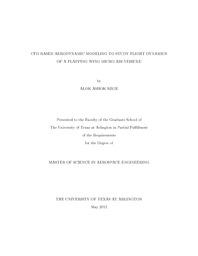
ATTENTION: The works hosted here are being migrated to a new repository that will consolidate resources, improve discoverability, and better show UTA's research impact on the global community. We will update authors as the migration progresses. Please see MavMatrix for more information.
Show simple item record
| dc.contributor.author | Rege, Alok Ashok | en_US |
| dc.date.accessioned | 2012-07-25T19:08:14Z | |
| dc.date.available | 2012-07-25T19:08:14Z | |
| dc.date.issued | 2012-07-25 | |
| dc.date.submitted | January 2012 | en_US |
| dc.identifier.other | DISS-11720 | en_US |
| dc.identifier.uri | http://hdl.handle.net/10106/11037 | |
| dc.description.abstract | The demand for small unmanned air vehicles, commonly termed micro air vehicles or MAV's, is rapidly increasing. Driven by applications ranging from civil search-and-rescue missions to military surveillance missions, there is a rising level of interest and investment in better vehicle designs, and miniaturized components are enabling many rapid advances. The need to better understand fundamental aspects of flight for small vehicles has spawned a surge in high quality research in the area of micro air vehicles. These aircraft have a set of constraints which are, in many ways, considerably different from that of traditional aircraft and are often best addressed by a multidisciplinary approach. Fast-response non-linear controls, nano-structures, integrated propulsion and lift mechanisms, highly flexible structures, and low Reynolds aerodynamics are just a few of the important considerations which may be combined in the execution of MAV research. The main objective of this thesis is to derive a consistent nonlinear dynamic model to study the flight dynamics of micro air vehicles with a reasonably accurate representation of aerodynamic forces and moments. The research is divided into two sections. In the first section, derivation of the nonlinear dynamics of flapping wing micro air vehicles is presented. The flapping wing micro air vehicle (MAV) used in this research is modeled as a system of three rigid bodies: a body and two wings. The design is based on an insect called Drosophila Melanogaster, commonly known as fruit-fly. The mass and inertial effects of the wing on the body are neglected for the present work. The nonlinear dynamics is simulated with the aerodynamic data published in the open literature. The flapping frequency is used as the control input. Simulations are run for different cases of wing positions and the chosen parameters are studied for boundedness. Results show a qualitative inconsistency in boundedness for some cases, and demand a better aerodynamic data. The second part of research involves preliminary work required to generate new aerodynamic data for the nonlinear model. First, a computational mesh is created over a 2-D wing section of the MAV model. A finite volume based computational flow solver is used to test different flapping trajectories of the wing section. Finally, a parametric study of the results obtained from the tests is performed. | en_US |
| dc.description.sponsorship | Subbarao, Kamesh | en_US |
| dc.language.iso | en | en_US |
| dc.publisher | Aerospace Engineering | en_US |
| dc.title | CFD Based Aerodynamic Modeling To Study Flight Dynamics Of A Flapping Wing Micro Air Vehicle | en_US |
| dc.type | M.S. | en_US |
| dc.contributor.committeeChair | Subbarao, Kamesh | en_US |
| dc.degree.department | Aerospace Engineering | en_US |
| dc.degree.discipline | Aerospace Engineering | en_US |
| dc.degree.grantor | University of Texas at Arlington | en_US |
| dc.degree.level | masters | en_US |
| dc.degree.name | M.S. | en_US |
Files in this item
- Name:
- Rege_uta_2502M_11720.pdf
- Size:
- 6.728Mb
- Format:
- PDF
This item appears in the following Collection(s)
Show simple item record


